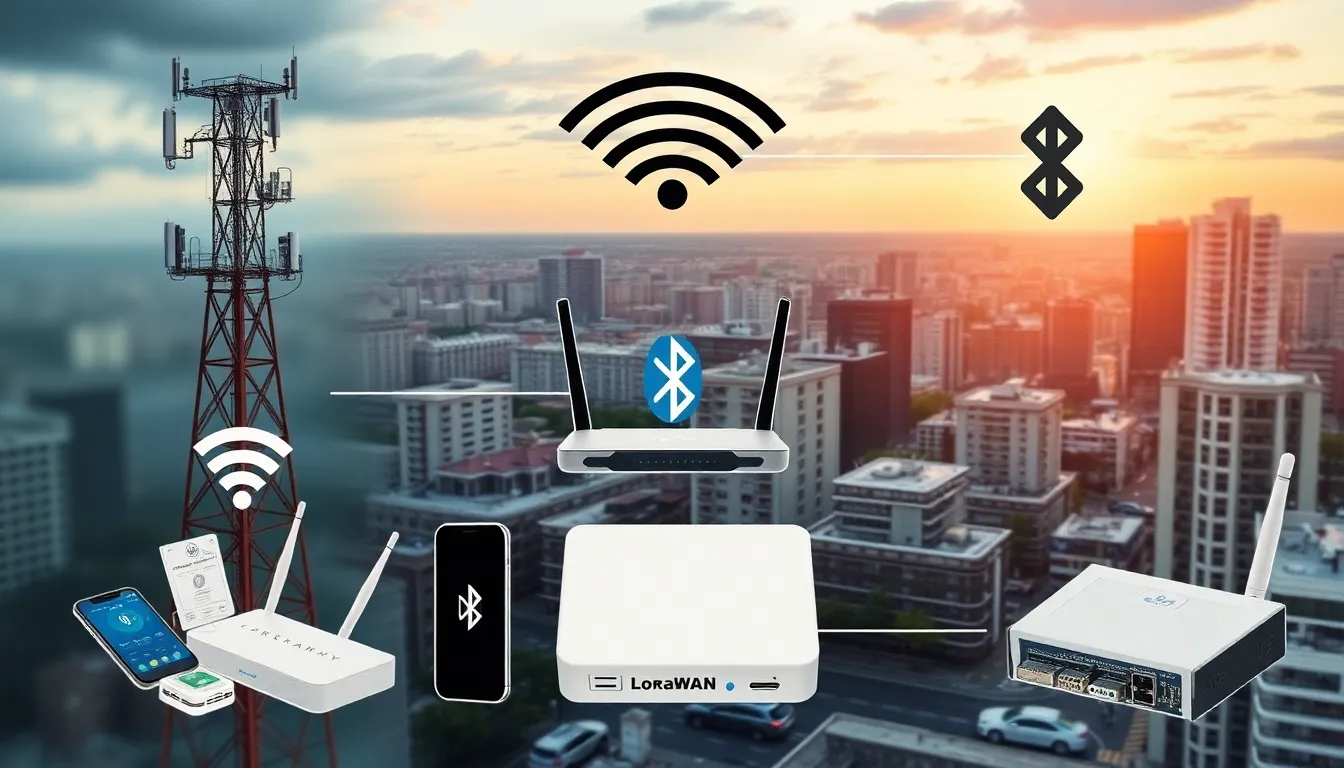In a world where your fridge can text you when you’re low on milk, the Internet of Things (IoT) is no longer just a sci-fi fantasy. It’s a reality that’s transforming everyday life, making it smarter, faster, and a tad more entertaining—who knew appliances could have such personality? But behind this tech magic lies a crucial component: connectivity solutions that keep all those gadgets talking to each other.
Table of Contents
ToggleOverview of IoT Connectivity Solutions
IoT connectivity solutions enable devices to communicate seamlessly. These solutions include various technologies that facilitate reliable connections among smart devices. Cellular networks, for instance, provide extensive coverage and high-speed transmission.
LPWAN (Low Power Wide Area Network) options stand out for their long-range capabilities. Technologies like LoRaWAN offer low power consumption, making them suitable for battery-operated devices in remote locations. Wi-Fi remains widely used for indoor devices, allowing for easy connections to the internet.
Bluetooth technology supports proximity-based applications, connecting devices without needing internet access. Its low-energy variant allows smaller devices to operate efficiently. Zigbee and Z-Wave focus on home automation, creating robust mesh networks that enhance communication between smart home devices.
Satellite communication solutions extend connectivity to inaccessible areas. These solutions prove invaluable for agriculture or transportation industry applications. Multiple providers, such as Iridium, offer satellite options tailored for IoT connectivity.
Network protocol standards, including MQTT (Message Queuing Telemetry Transport) and CoAP (Constrained Application Protocol), facilitate efficient data exchange. MQTT, for instance, optimizes messaging for low-bandwidth scenarios, enhancing performance in IoT systems.
Choosing a connectivity solution depends on specific use cases. Factors like range, power consumption, and data rate significantly influence decisions. Businesses can evaluate their needs based on these parameters to select the most suitable solution.
Understanding various connectivity options enhances IoT deployment strategies, ensuring devices communicate efficiently. They ultimately contribute to smarter, more connected environments that improve everyday life.
Types of IoT Connectivity Solutions

Understanding the various types of IoT connectivity solutions is essential for effective deployment and functionality of smart devices. Each solution offers unique benefits tailored to specific applications.
Cellular Connectivity
Cellular networks serve as a reliable choice for IoT devices that need extensive coverage. They effectively handle high data demands, making them suitable for applications like vehicle tracking and smart city services. Technologies like 4G and 5G significantly enhance data transfer speeds and capacity. Cellular solutions operate on established infrastructure, allowing for seamless global connectivity. Providers like Verizon and AT&T support numerous IoT applications through dedicated cellular networks.
Wi-Fi Connectivity
Wi-Fi provides a flexible and cost-effective option for indoor IoT devices. It allows high data transfer rates, which suit applications like smart home devices and security cameras. Scalability remains a strong feature; adding more devices typically requires minimal changes to the existing network. Commonly found in homes and offices, Wi-Fi enables robust connectivity in environments with significant device concentration. With the arrival of Wi-Fi 6, data handling becomes even more efficient, accommodating more simultaneous connections.
Bluetooth Connectivity
Bluetooth excels in short-range connections among devices. It caters to use cases such as wearable technology and home automation, where energy efficiency is crucial. Low power consumption ensures devices can operate for long periods on small batteries. Many devices utilize Bluetooth for straightforward pairing, promoting user-friendly interactions. Technologies like Bluetooth Low Energy (BLE) enhance the protocol’s capabilities, making it well-suited for IoT applications that prioritize battery life.
LoRaWAN Connectivity
LoRaWAN stands out for applications requiring low-power, long-range communication. Ideal for remote and rural areas, it supports devices such as agricultural sensors and environmental monitors. LoRaWAN ensures minimal energy usage, allowing devices to operate over extended periods. Operated in unlicensed frequency bands, this connectivity solution circumvents heavy regulatory requirements. Its ability to connect numerous devices over vast distances makes it a compelling choice for scalable IoT networks.
Factors to Consider When Choosing Solutions
Selecting the right IoT connectivity solution involves careful consideration of several critical factors. Understanding these aspects ensures optimal performance and efficiency of interconnected devices.
Range and Coverage
Range and coverage play a crucial role in the effectiveness of IoT applications. Devices, operating in remote areas, require reliable connectivity, which is where LPWAN technologies excel. For instance, cellular networks offer extensive coverage, making them suitable for urban and rural deployments. Wi-Fi provides a solid solution for indoor environments, but its range diminishes outside. Bluetooth’s short-range capabilities limit its application to personal devices or within a confined space. Ultimately, identifying the specific environment and requirements determines the best connectivity option.
Data Speed and Transfer Rates
Data speed and transfer rates significantly impact the performance of IoT solutions. Cellular networks generally deliver the highest data rates, catering to applications requiring real-time data, such as vehicle tracking. In contrast, Wi-Fi supports faster transfer rates for multiple devices in homes and offices, thus allowing smooth streaming and downloads. Low-power solutions, like LoRaWAN, sacrifice speed to achieve longer ranges, making them suitable for applications needing fewer data exchanges. Assessing the data demands of applications informs the selection of a connectivity solution that meets necessary speed requirements.
Power Consumption
Power consumption affects the longevity and efficiency of IoT devices, especially those deployed in remote locations. Battery-operated sensors benefit from low-power technologies, such as LoRaWAN or Zigbee, extending operational life significantly. Cellular solutions usually consume more energy but provide higher performance, making them ideal for applications with consistent power sources. Wearables and smart devices often leverage Bluetooth due to its energy-efficient connection methods. Evaluating the power needs of devices helps determine the most suitable connectivity option, balancing performance and energy consumption effectively.
Challenges in IoT Connectivity
IoT connectivity faces several challenges that can hinder its effectiveness and security. These challenges include security concerns and interoperability issues, both critical for the seamless operation of IoT systems.
Security Concerns
Security remains a top priority when establishing IoT connectivity. Vulnerabilities in devices can expose sensitive data to cyber threats. For instance, insecure protocols and weak authentication methods allow unauthorized access to smart devices, creating potential data breaches. Protecting data transmission through encryption helps mitigate risks, yet many devices lack robust security measures. Additionally, the sheer volume of connected devices complicates security management, making comprehensive network monitoring essential. Organizations must implement regular security audits and updates to safeguard IoT infrastructure against evolving threats.
Interoperability Issues
Interoperability stands as a significant challenge in IoT connectivity. Different devices often use disparate communication protocols, creating compatibility hurdles. Without standardized protocols, devices from various manufacturers struggle to communicate effectively. For example, a smart thermostat may not work seamlessly with a home security system due to differing technologies. Establishing compatibility between devices requires adoption of common frameworks. Industry cooperation plays a crucial role in developing universal standards that enhance device integration and user experience. Ensuring smooth interactions among connected devices fosters a more efficient and effective IoT ecosystem.
Future Trends in IoT Connectivity Solutions
Future trends in IoT connectivity solutions focus on enhancing device integration and communication efficiency, addressing growing demands in various industries.
5G Integration
5G technology transforms IoT connectivity by providing higher bandwidth and faster data rates. Greater speeds allow for real-time data processing and communication, essential for applications like autonomous vehicles and smart cities. With 5G, latency decreases significantly, enhancing the responsiveness of connected devices. This integration supports a larger number of simultaneous connections, accommodating the increasing volume of smart devices in urban areas. Furthermore, industries leveraging 5G can experience improved operational efficiency, as real-time analytics become more accessible.
Edge Computing Impact
Edge computing facilitates data processing closer to the data source, reducing the necessity for extensive cloud communication. By processing data locally, devices lower latency and enhance response times, crucial for time-sensitive applications. This approach minimizes bandwidth use, freeing up network capacity for additional devices. Security benefits arise as fewer data transmissions occur across wide networks, decreasing potential vulnerabilities. As more IoT devices emerge, edge computing becomes vital, allowing seamless real-time analytics and more robust network performance. The trend toward edge computing aligns with the need for scalable and reliable IoT systems.
The evolution of IoT connectivity solutions is reshaping how devices interact and communicate. By selecting the right technology based on specific needs, users can optimize their smart environments for efficiency and convenience. As innovations like 5G and edge computing emerge, they promise to enhance connectivity and reduce latency, paving the way for more advanced applications.
Addressing challenges such as security and interoperability remains crucial for creating a seamless IoT ecosystem. With ongoing advancements and a focus on standardized protocols, the future of IoT looks promising. As the landscape continues to evolve, staying informed about connectivity options will empower users to leverage the full potential of their smart devices, ultimately enriching their daily lives.



